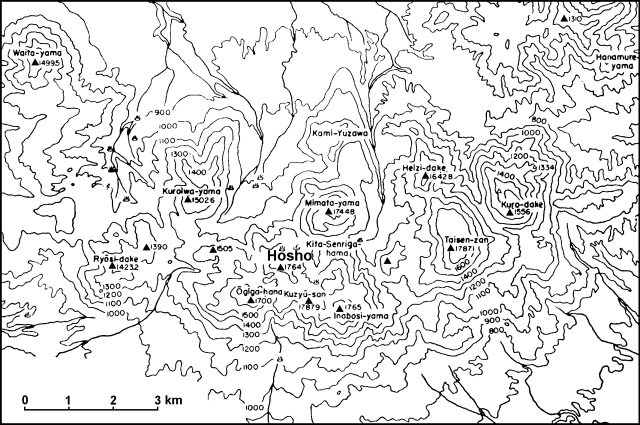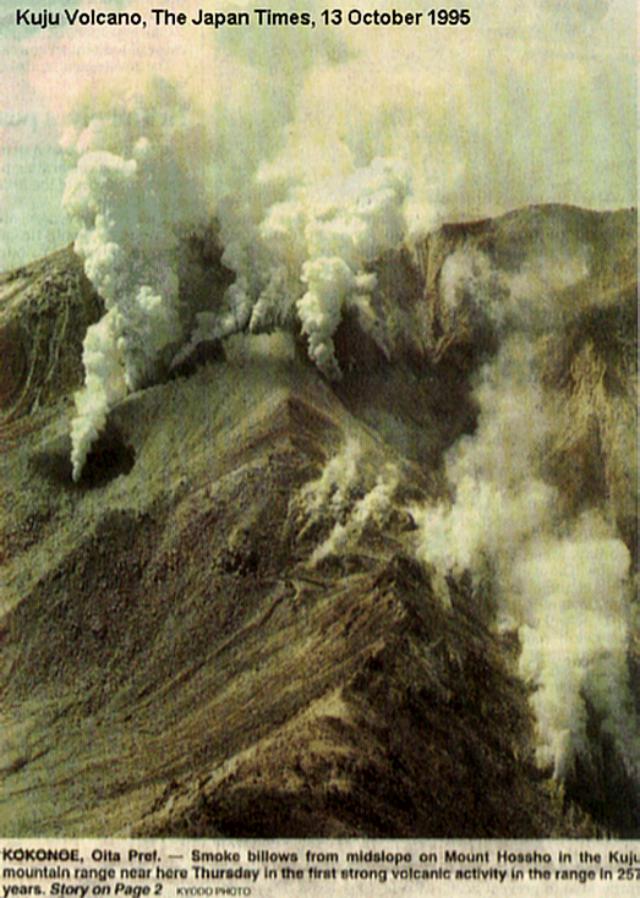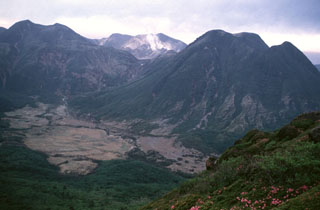Report on Kujusan (Japan) — September 1995
Bulletin of the Global Volcanism Network, vol. 20, no. 9 (September 1995)
Managing Editor: Richard Wunderman.
Kujusan (Japan) Phreatic explosion on 11 October causes ashfall 60 km away
Please cite this report as:
Global Volcanism Program, 1995. Report on Kujusan (Japan) (Wunderman, R., ed.). Bulletin of the Global Volcanism Network, 20:9. Smithsonian Institution. https://doi.org/10.5479/si.GVP.BGVN199509-282120
Kujusan
Japan
33.086°N, 131.249°E; summit elev. 1791 m
All times are local (unless otherwise noted)
The observation of "smoke" in the Kuju Volcano Group (figure 1) near the Hosho dome (summit elevation 1,762 m, figure 2) at about 1800 on 11 October prompted the local meteorological observatory to issue a volcano alert. Ashfall from the phreatic activity was observed in towns as far as 60 km away, but there was no noticeable seismicity. When observed by the Kyushu Mobile Volcano Observation Team at 1430 on 12 September, steam was rising 400 m from around mid-slope on the dome. At that time there were three vents and fissure vents on the E slope of Hosho in an area ~300 m E-W by 100 m N-S. A photograph published in the Japan Times on 13 October (figure 3) showed steam emissions from numerous points along one ridge of the dome.
 |
Figure 1. Map of central and southern Kyushu Island, showing selected cities and historically active volcanoes. Courtesy of Tokiko Tiba. |
 |
Figure 2. Map of the Kuju Volcano Group (modified from Kuno, 1962). Hosho Dome is near the center of the group. |
 |
Figure 3. Photograph of steam emissions from the Hosho dome at Kuju. Scanned from a photograph published in the Japan Times, 13 October 1995. |
Reference. Kuno, H., 1962, Japan, Taiwan, and Marianas: Catalog of active volcanoes of the world, part 11, p. 54-57.
Geological Summary. Kujusan is a complex of stratovolcanoes and lava domes lying NE of Aso caldera in north-central Kyushu. The group consists of 16 andesitic lava domes, five andesitic stratovolcanoes, and one basaltic cone. Activity dates back about 150,000 years. Six major andesitic-to-dacitic tephra deposits, many associated with the growth of lava domes, have been recorded during the Holocene. Eruptive activity has migrated systematically eastward during the past 5000 years. The latest magmatic activity occurred about 1600 years ago, when Kurodake lava dome at the E end of the complex was formed. The first reports of historical eruptions were in the 17th and 18th centuries, when phreatic or hydrothermal activity occurred. There are also many hot springs and hydrothermal fields. A fumarole on Hosho lava dome was the site of a sulfur mine for at least 500 years. Two geothermal power plants are in operation at Kuju.
Information Contacts: Volcanological Division, Seismological and Volcanological Department, Japan Meteorological Agency (JMA), 1-3-4 Ote-machi, Chiyoda-ku, Tokyo 100 Japan; Tokiko Tiba, Department of Geology, National Science Museum, 3-23-1 Hyakunin-cho, Shinjuku-ku, Tokyo 169, Japan; The Japan Times, Tokyo, Japan.

